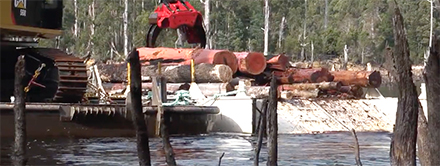The “lost trees of Hydrowood” have become a part of the lore of Tasmania’s West Coast. Lake Pieman was dammed in 1986, and since 2015 the “lost trees” from the lake floor have been cut, dried, and recreated into objects that can be enjoyed for a lifetime- from boats, homes, furniture, and homewares. Source: The Examiner
The story behind Hydrowood and its finite nature has made it a valuable addition to ‘Brand Tasmania’, with a pilot program funded by the Department of State Growth designed to protect its provenance. Hydrowood co-founder Andrew Morgan said Hydrowood’s Tasmanian story was the biggest part of its appeal and it needed to be protected.
“Everyone loves the story, they’re intrigued by it, they’re intrigued by the West Coast of Tasmania and its beauty,” Mr Morgan said. “The concept of salvaging timber out of a lake that’s been sitting there for 30 years, really does capture people’s imagination.”
Mr Morgan said Hydrowood comes from the “lake to the lounge”, and that effectively tracing its provenance would give consumers greater confidence.
“Hydrowood is very much about the Tasmanian story, it’s about the provenance, it’s about the place,” he said.
“It’s very strongly Tasmanian so we want to make sure that when our product goes to the world, the consumer has a level of confidence.”
Using a QR code and blockchain technology, the Tasmanian-origin tracing technology will allow consumers to confirm the authenticity of Hyrdrowood, with hopes to roll the technology out to other Tasmanian products.
“Tasmania has was the rest of the world wants and needs, so Tasmania is very proud of the Tasmanian brand,” Trade Minister Guy Barnett said.
“The Tasmanian brand is particularly important, so we have partnered with Hydrowood to ensure that we protect the Tasmanian brand from fraudsters.
“The art of Tasmanian-born artist Brodie Neil was the first to use the QR code technology, with his piece ReCoil currently on display at London Craft Week. ReCoil is made entirely of Hyrdrowood timber veneer offcuts, with seven native Tasmanian tree species featured.
Mr Barnett said the pilot program held promise for other Tasmanian products and industries and hoped it would become protocol.
“It has applications for specialty timber but it also has applications for agriculture and seafood, these are things that are very important to Tasmania,” Mr Barnett said.
“We’ve got something that’s really important here in Tasmania, and we want that protected all the way through the supply chain.”






